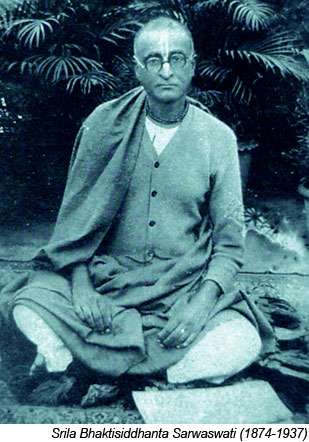by Dhanurdhara Swami


CLICK TO VIEW ARTICLE (right-click to download to your own hard drive)
Dhanurdhara Swami’s paper, Srila Bhaktisiddhanta and Raganuga Sadhana
Bhakti explores a central point of contention regarding the influence
of Vaishnava reformer and modernizer, Sri Bhaktisiddhanta Sarasvati (1874 – 1937).
The following is meant to serve as a brief introduction, as the paper’s primary
audience are those persons who are somewhat familiar with the Gaudiya
tradition and the main forms of sadhana which it advocates.
Like other traditions of late-Medieval Indian spirituality, Gaudiya
Vaishnavism, the tradition stemming from Sri Caitanya Mahaprabhu
(1486-1533), developed visualization techniques to aid the meditation of
adept practitioners. Such techniques are often passed down from guru to
disciple in some form of initiation. The purpose of these practices, called
Raganuga Sadhana Bhakti (“the devotional practice which follows from deep
attachment”) is well summarized by scholar David Haberman:
The goal of Raganuga Bhakti Sadhana is to shift identity. . . [to] the
“perfected form” (siddha-rupa), which is one’s true and ultimate identity.
Salvation, to the Gaudiya Vaishnavas, is unending participation in the
cosmic drama, and the skills of the actor are employed in pursuit of the
true identity which allows such participation. (Acting as a Way of
Salvation, Motilal Edition, 4)
Such practices are traditionally nourished by absorption in kirtan, which,
for Gaudiyas, takes the form of nama-sankirtana, meditation on God’s
(Krishna’s) names. It should be underscored that the visualization practices
involved in raganuga sadhana bhakti are highly esoteric. Most members of the
tradition (including non-renunciates and most lay persons) do not engage in
it, though, doubtless, they engage in some kind of kirtana. Most hope to
eventually practice some form of Raganuga sadhana when they are spiritually
prepared.
Dhanurdhara Swami’s paper discusses the decision by Sri Bhaktisiddhanta to
deemphasize certain developments of Raganuga sadhana, particularly what is
called ekadasa-bhava, where a guru imparts to the disciple different
features of his or her siddha-rupa at the time of initiation.
Bhaktisiddhanta instead focused on the performance and promulgation of
kirtana. This was part of Bhaktisiddhanta’s adjustments to Gaudiya Vaishnava
tradition in the face of modernity, and is a source of no small contention
among his critics. What makes Bhaktisiddhanta and his reforms so important
is that his followers are largely responsible for the global awareness of
Gaudiya Vaishnava religion and culture (including kirtana). Dhanurdhara
Swami argues that Bhaktisiddhanta’s reforms are quite within the tradition’s
boundaries–in fact, he argues, they help manifest the heart of the
tradition, not obscure it. He further argues that both critics and followers
of Bhaktisiddhanta must understand the spirit behind such reforms, lest they
forget Bhaktisiddhanta’s deep engagement with tradition.
-MD
To read the article follow the link above.
Comments
One response to “Srila Bhaktisiddhanta and Raganuga Sadhana Bhakti”
Dear Maharaja,
koti dandavat pranama
sri sri guru gaurangau jayatah
Thank you for sharing your article, which is both timely and highly instructive.
If you will indulge me, i would like to suggest that it could be helpful to look into other traditions for parallel developments, and thus contextualize Srila Bhakti Siddhanta’s reforms more broadly. In particular, the Buddhist Mahayana, known for its highly complex and multifarious upayas (84,000 methods), underwent a similar transformation, leading to Pure Land becoming the dominant Buddhist tradition in East Asia.
Honen and Shinran (12th and 13th centuries, respectively) in Japan, and Chu-hung and Tsung-pen (16th Century) in China, are outstanding exponents of this reform, centered on exclusive recitation of the Name of Amida (Amitabha, the Buddha of the Western Pure Land). Importantly, they assert that recitation is not only the essential practice for this time of degradation, but that all other practices emanate from pure recitation. The Chinese exponents, in particular, take pains establishing how meditation practices (Ch’an, Zen) are non-different and included in recitation.
Similarly, St Gregory Palamas (14th century) gave sound theological basis for the recitation of the Name (Jesus Prayer) as the most important practice within Christian monasticism, and the Sufi practice of Zikr also comes to mind, although i confess gross ignorance about Islam in general and Zikr in particular.
Congratulations on this important publication.
Please accept my full obeisances, and my prayers that you will remember this servant with your accustomed kindness.
Your servant,
Nimai Nitaidas